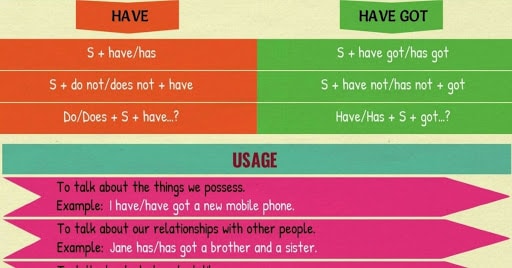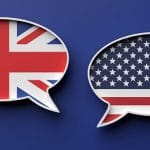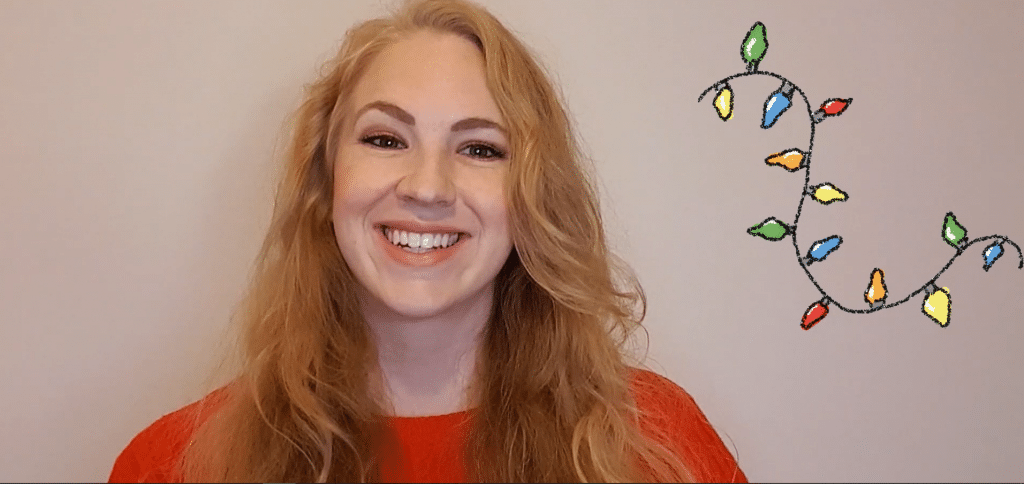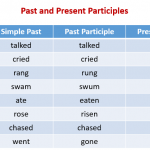Ecco una altra lezione di inglese online per chi vuole imparare in fretta!
Il verbo avere è molto importante in inglese, come in italiano, perchè può avere diverse funzioni e significati:
- come verbo indipendente, avere nel significato di possedere
- come verbo indipendente, avere nel significato di fare, prendere, dovere
- come verbo ausiliare, nella costruzione dei verbi composti inglesi
- in molte espressioni idiomatiche
Nei nostri corsi online di inglese affrontiamo spesso questo tema, che è ostico per gli italiani per i problemi di interferenza linguistica. Specie nei corsi di inglese per bambini, tuttavia, bastano dei giochi mirati e flashcards per fare capire i molti diversi usi del verbo avere in inglese
Contenuti di questa pagina
Have in inglese: verbo avere nel senso di possedere
Il primo e più ovvio dei significati del verbo HAVE è avere, nel senso di possedere, avere a disposizione.
In questo significato, può essere rafforzato da GOT (qui trovate un articolo dedicato alla differenza tra have e have got , mentre qui trovate qui delle idee per insegnare have got)
Ecco alcuni esempi
I have a brother
I have got a brother
She as blue eyes
She has got blue eyes
Have in inglese: nel significato di fare/prendere
Have non vuole dire solo “avere”, ma è anche usato in una serie di espressioni che potremmo sintetizzare con il significato di prendere/fare. Qui ne elenchiamo un po’, dopodichè cercheremo di dare un riassunto che ci aiuti a ricordare le regole con poche categorie veramente semplificate
Espressioni che hanno a che fare con la nutrizione
- Have breakfast, lunch, dinner, a snack.…: si usa “have” + nome del pasto nel senso di mangiare (pranzare, cenare, fare colazione, merenda)
- Have a slice, have a sip, have a bite, have a glass, have a bit: si usa “have” + “unità di misura” di cibo, nel senso di assumere/mangiare una fetta, un bicchiere, un sorso, un morso
- Have food/drink (have a chocolate, have a candy, have a coffee, have a drink, have a coke, have a tea, have a sandwich…) in generale mettendo have +nome del cibo o bevanda , il significato è mangiare.
Espressioni che hanno a che fare con la pulizia, la cura del corpo
- Have a shower, have a bath, have a wash: have + nomi legati alla pulizia significano “assumere” e si possono tradurre come fare il bagno, la doccia, lavarsi
Espressioni che hanno a che fare con il riposo e la ricreazione
- Have a rest: riposarsi
- have a nap: fare un riposino
- Have fun: divertirsi
- Have a good/bad time: divertirsi, non divertirsi
- Have a party, have a chat: andare ad una festa, conversare
Espressioni che hanno a che fare con la posizione del corpo nello spazio e le azioni:
- Have a seat: sedersi
- Have a walk: camminare
Vuoi restare in contatto con noi
(e ricevere materiali gratuiti sulla mail)?
Verbo Have o take
Possiamo dire che il verbo “have” diventa un sinonimo di “take” quando è usato con una serie di espressioni che riguardano il corpo (nutrizione, benessere, pulizia, azione)
Have si può usare con una serie di espressioni che significano pausa/vacanza :
- have a break: fare una pausa/intervallo
- have a holiday: fare una vacanza
- have a pause: fare una pausa
- have a nap: fare un sonnellino
Verbo Have to nel senso di dovere
Have to + verbo infinito significa DOVERE. Di questo abbiamo parlato in questo articolo
esempio:
You have to study = You must study
Spesso a “to have to” si aggiunge “got”.
You have got to call him back (Devi richiamarlo)
I have got to finish my homework before going out (Devo finire i compiti prima di uscire)
Verbo Have + participio passato nelle frasi causative
In inglese si utilizzano le frasi causative (causatives) per indicare un’azione che qualcuno ha compiuto per una terza persona.
In questo tipo di farsi, il soggetto della proposizione causa l’azione, la quale non è però compiuta dal soggetto ma da qualcun altro.
Esempio: We’re having our house painted significa che noi abbiamo chiesto a qualcun altro di pitturare la nostra casa. Noi siamo “i mandanti” dell’azione di pitturare casa. Abbiamo quindi chiesto a degli imbianchini di pitturare casa.
Lo traduciamo come: “Stanno pitturando casa nostra”, ma significa che noi abbiamo chiesto a qualcuno di farlo.
Il costrutto causativo è
HAVE / GET SOMETHING DONE
Coniugazione del verbo avere in inglese
Il verbo avere inglese è irregolare.
Il paradigma del verbo have è il seguente
Have/had/had
Coniugazione del verbo have al simple present
Al simple present, tempo verbale che indica azioni ripetute o sempre vere ed oggettive al tempo presente, questa è la coniugazione verbale, alle tre forme affermativa, negativa e interrogativa.
| Forma affermativa | Forma negativa | Forma interrogativa |
| I have | I have not I do not have | Have I? Do I have? |
| You have | You have not You do not have | Have you? Do you have? |
| He, she, it has | He, she, it has not He/she/it does not have | Has he/she, it? Does he/she/it have |
| We have | We have not We do not have | Have we? Do we have? |
| You have | You have not You do not have | Have you? Do you have? |
| They have | They have not They do not have | Have they? Do they have? |
Verbo have al simple present – forme contratte
Le forme contratte sono state affrontate in questo articolo.
Vediamo qui in tabella le forme affermativa e negativa contratto
| Forma affermativa | Forme negativa |
| I have –> I’ve | I have not –> I haven’t got |
| You have -> you’ve | You have not –> You haven’t |
| He, she, it has –> he, she, it’s | He, she, it has –> he, she, it hasn’t |
| We have –> We’ve | We have not–> We haven’t |
| You have –> You’ve | You have not –> You haven’t |
| They have –> They’ve | They have not –> You haven’t |

Forma negativa e interrogativa di have: si usa l’ausiliare do?
La forma negativa e interrogativa del verbo avere , nel suo significato di verbo indipendente, si forma con l’ausiliare DO (come ogni altro verbo)
Quindi , la forma negativa di frasi come
I have a book e’ I DO NOT HAVE a book
Tuttavia, esiste anche la forma senza l’ausiliare do, che si usa:
- quando il verbo have è usato come ausiliare (I have not seen you, ma il verbo è SEE – have è solo ausiliare)
- quando si usa have got (il negativo di I have got blue eyes è I haven’t got blue eyes)
Vuoi fare lezione con noi?
Verbo avere in inglese al present continuous
Il verbo HAVE alla forma di presente progressivo, che viene usato per esprimere un’azione in svolgimento mentre il parlante la sta esprimendo. Qui abbiamo spiegato il present continuous, mentre della differenza tra simple present e present continuous ne abbiamo parlato qui.
Il present continuous si può usare anche come forma futura, come spieghiamo in questo articolo
Il verbo have al present continuous ha questa coniugazione
| Forma affermativa | Forma negativa | Forma interrogativa |
| I am having | I am not having | Am I having? |
| You are having | You are not having | Are you having? |
| He, she, it has having | He, she , it has not having | Is he/she/it having? |
| We are having | We are not having | Are we having? |
| You are having | You are not having | Are you having? |
| They are having | They are not having | Are they having? |
Verbo avere in inglese – coniugazione al present perfect
Il present perfect è una forma verbale composta, usata per indicare un’azione iniziata nel passato che è ancora vera nel presente o di cui si sottolineano i risultati nel presente . Del significato ed uso del present perfect abbiamo parlato in questo articolo.
E’ interessante osservare questa forma del verbo TO HAVE perché abbiamo have sia come verbo ausiliare (alla forma coniugata), che come verbo principale (al participio)
| Forme affermativa | Forma negativa | Forma interrogativa |
| I have had | I have not (haven’t) had | Have I had? |
| You have had | You have not have (haven’t) had | Have you had? |
| He, she, it has had | He, she , it has (hasn’t) had | Has he/she/it had? |
| We have had | We have not (hasn’t) had | Have we had? |
| You have had | You have not (haven’t) had | Have you had? |
| They have had | They have not (haven’t) had | Have they had? |
Verbo “have” al simple past
Il simple past è una forma usata per descrivere azioni concluse al passato. Si trova spesso quando c’è una chiara indicazione di quando si è svolta nel passato una data azione (yesterday, 11 years ago, in 1898…) La forma del simple past del verbo TO HAVE è quella che indichiamo in tabella.
Notate che esistono due maniere alternative, entrambe corrette, per costruire il simple past del verbo have alla forma negativa e interrogativa.
Ecco le forme
| Forma affermativa | Forma negativa | Forma interrogativa |
| I had | I did not have | Did I have? |
| You had | You did not have | Did you have? |
| He, she, it had | He, she, it did not have | Did he/she/it have? |
| We had | We did not have | Did we have? |
| You had | You did not have | Did you have? |
| They had | They did not have | Did they have? |
Si usa did o had al simple past del verbo have?
E’ una domanda che si sente fare spesso. Visto che esistono entrambe le forme, come si è visto in tabella (DID/HAD), come ci si deve regolare? Esistono delle differenze?
Quando HAVE è usato come ausiliare (per esempio nella formazione dei tempi composti dei verbi) non si può mai usare l’ausiliare DO nella forma interrogativa, negativa e interrogativo-negativa.
Esempio:
I had not seen that movie.
Had she read that book?
Ma quando il verbo HAVE è usato in modo indipendente (significato di possedere o una delle altre espressioni indicate a inizio pagina) si usa l’ausiliare DID al passato per fare il verbo negativo o interrogativo.
Did you have a nap?
I did not have breakfast.
In altre parole, quando have è usato nel suo significato di verbo indipendente, si comporta come tutti gli altri verbi, ovvero prende DO come ausiliare.
Coniugazione del verbo avere in inglese al past continuous
Il verbo avere al simple past si coniuga con il verbo to be al passato + ing form del verbo principale
| Affirmative Form | Negative Form | Question Form |
| I was having | I was not (wasn’t ) having | Was I having? |
| You were having | You were not (weren’t) having | Were you having? |
| He, she, it was having | He, she was not (wasn’t ) having | Was he/she/it having? |
| We were having | We were not (weren’t) having | Were we having? |
| You were having | You were not (weren’t) having | Were you having? |
| They were having | They were not (weren’t) having | Were they having? |
Present Perfect Continuous del verbo avere in inglese
Questa è la coniugazione del verbo avere al present perfect continuous
| Affirmative Form | Negative Form | Question Form |
| I have been having | I have not (haven’t) been having | Have I been having? |
| You have been having | You have not (haven’t) been having | Have you been having? |
| He/She/it has been having | He/She/it has not (hasn’t) been having | Has he/she/it been having? |
| We have been having | We have not (haven’t) been having | Have we been having? |
| You have been having | You have not (haven’t) been having | Have you been having? |
| They have been having | They have not (haven’t) been having | Have them been having? |
Ti è piaciuto l’articolo? Ricordati di condividerlo o di iscriverti alla mailing list!









Lascia un commento